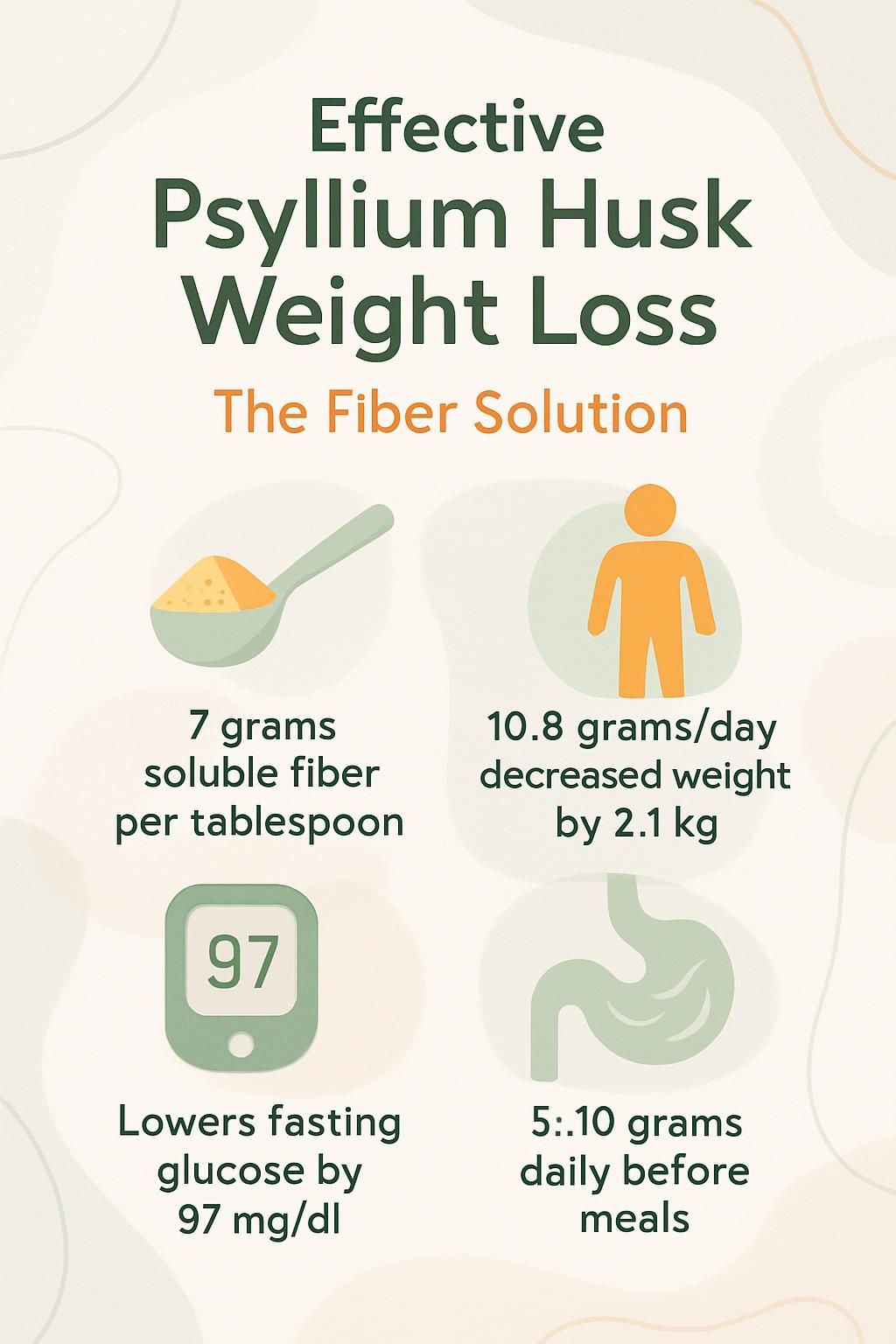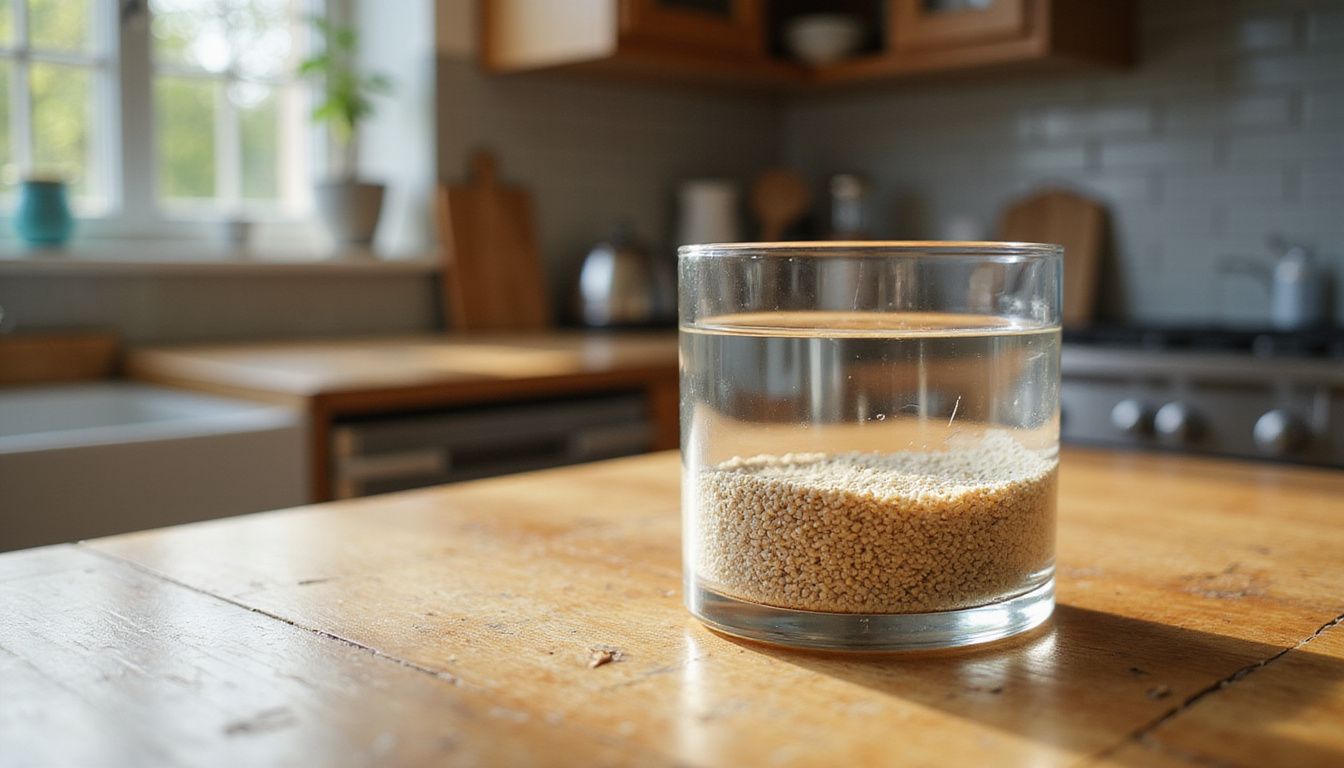Effective Psyllium Husk Weight Loss: The Fiber Solution
Our Nutrition Assistant AI Suite will transform your body. You will lose fat, get toned, and build muscle. Gain confidence and optimal health.
You may be fighting stubborn weight or nonstop hunger even after trying many diets. Increasing fiber, especially psyllium husk, can help with appetite, digestion, and steady progress. This simple step supports weight loss and better health without complicated rules.
This guide explains what psyllium husk is, how it creates fullness, and why it supports blood sugar control. You will also see safe ways to use it, backed by research, plus easy tips you can start today. A small daily routine can make a real difference.
Key Takeaways
- Psyllium husk comes from Plantago ovata seeds. One tablespoon gives about 7 grams of soluble fiber that helps you feel full and eat fewer calories.
- A 2023 meta-analysis of six randomized controlled trials found an average drop of 2.1 kg in body weight and 0.8 kg/m² in BMI with psyllium intake near 10.8 grams per day.
- In people with type 2 diabetes, psyllium lowered fasting glucose by 37 mg/dl and HbA1c by 0.97%, based on Gibb et al., 2015.
- Experts often suggest 5 to 10 grams daily, taken before meals with plenty of water, to improve digestion and support weight control.
- Evidence cited by the American College of Gastroenterology and McRorie et al., 2020, shows psyllium beats many fibers for stool output, cholesterol reduction, and blood pressure support.

Understanding Psyllium Husk

Psyllium husk is a natural fiber from the Plantago ovata plant. It is a gel-forming soluble fiber, which means it absorbs water and thickens in your gut. That gel helps with fullness and supports a steady digestive rhythm.
What is the origin and definition of psyllium husk?
Psyllium husk is harvested from Plantago ovata seeds grown mainly in India and parts of South Asia. In research and on product labels, you may also see the name ispaghula.
It is the active fiber in popular over-the-counter laxatives such as Metamucil. Farmers process the tiny husks because they swell in water and form a gel that moves through the gut mostly undigested and only lightly fermented. This action supports regularity without harsh stimulants.
Psyllium has surged online, with thousands of TikTok videos discussing weight loss and better blood sugar control. The social buzz is strong, yet the best support comes from clinical trials and medical reviews.
In my own routine, a small serving of psyllium before breakfast helped calm mid-morning hunger and kept me regular.
What are the key nutritional values and fiber content of psyllium husk?
Each tablespoon of psyllium husk provides about 7 grams of fiber. Most of that fiber is soluble, which forms a thick gel in the small intestine. The gel increases viscosity, slows digestion, and smooths spikes in blood sugar.
Health groups suggest adults consume 25 to 30 grams of fiber daily. Yet only about 5% of Americans and 9% of UK adults meet that goal.
Typical psyllium intake ranges from 5 to 10 grams per day, split into 2 or 3 servings. This can close your fiber gap and support regular stools. Many people mix a teaspoon into oatmeal or yogurt, or shake it with water. Consistency, plus enough fluids, is key for comfort and results.
Psyllium Husk Benefits for Weight Loss
Psyllium husk fiber helps you manage hunger and eat fewer calories. It also supports stable blood sugar, which can cut cravings and mindless snacking.
How does psyllium husk enhance satiety to curb hunger?
Taking psyllium husk before meals helps you get full faster. The soluble fiber absorbs water and expands, creating a viscous gel in your stomach. That gel boosts stomach stretch signals, so your brain thinks, I have had enough.
Digestion also slows, so you stay satisfied longer. In a randomized control trial, participants who used psyllium before meals reported lower hunger and ate fewer calories over the day.
Across multiple trials, daily intakes of 5 to 10 grams improved satiety and supported weight control. For best results, take it right before meals with plenty of water.
The viscous gel formed by psyllium slows nutrient absorption and prolongs satiety, making it easier to manage calorie intake.
How does psyllium husk affect glucose absorption and blood sugar levels?
Psyllium slows glucose absorption in the small intestine by forming a gel that delays carbohydrate breakdown. Sugar enters the bloodstream more gradually, which steadies blood sugar after meals.
People with type 2 diabetes or metabolic syndrome may see better glycemic control. A meta-analysis by Gibb et al., 2015, showed reduced fasting glucose by 37 mg/dl and HbA1c by 0.97% with psyllium use.
Other trials reported lower fasting insulin and improved insulin resistance. Used as a dietary supplement, psyllium can support a smoother blood sugar curve.
How does psyllium husk help reduce calorie intake through appetite control?
Soluble fibers from psyllium thicken into a gel that delays stomach emptying. This keeps you full longer after a meal. Pre-meal use creates the strongest effect on appetite and snacking.
Studies find that people who consume psyllium tend to eat fewer calories at the next meal. Trials controlled overall calories to show that the effect of psyllium consumption goes beyond simple restriction. The result is easier dieting with fewer cravings.
Research supported by the National Institutes of Health highlights this appetite effect and its role in steady weight loss.
How Psyllium Husk Works
Psyllium is like a sponge that swells with water, then moves slowly through the gut. That slow movement drives fullness, regularity, and stable energy.
What is gel formation and how does it affect stomach fullness?
After you take psyllium with liquid, it soaks up water in the stomach and forms a thick gel. The gel fills space and slows the rate at which food leaves your stomach.
Because it stays largely intact as it moves along, you feel full longer. This steady fullness can reduce snacking and help you trim portions naturally.
In my evening routine, a small dose before dinner made me comfortable with smaller portions and cut late-night grazing.
How does psyllium husk improve digestive health and regularity?
Psyllium’s gel also supports smoother bowel movements. It softens stool while adding bulk, which helps prevent constipation and can ease diarrhea by normalizing stool form.
Evidence shows psyllium outperforms wheat bran for increasing stool output in chronic constipation, based on McRorie et al., 2020. The American College of Gastroenterology recommends isolated gel-forming fibers such as psyllium for irritable bowel syndrome.
Doctors also use psyllium for chronic idiopathic constipation. Many people notice more reliable bowel habits within days of steady use. It is gluten-free and fits most eating patterns.
How does psyllium influence blood sugar and insulin regulation?
Psyllium’s gel slows digestion of carbohydrates, which helps control the rise in blood sugar after meals. This can reduce the strain on insulin.
Studies including Abutair et al., 2016, and Cicero et al., 2010, found better fasting insulin levels and lower insulin resistance with psyllium. Gibb et al., 2015, reported lower fasting glucose and HbA1c as well.
Many people use psyllium safely along with diabetes medications. Always talk with a healthcare professional about timing and dose if you use glucose-lowering drugs.
Research on Psyllium Husk and Weight Loss
Evidence from controlled trials and a recent review supports psyllium’s role in weight and BMI changes. The pattern across studies is consistent and meaningful.
What do studies say about psyllium husk’s effects on weight loss?
Multiple trials show that psyllium husk can help you cause weight loss. A meta-analysis of six randomized controlled trials with 354 participants reported an average weight reduction of 2.1 kg.
Most participants took about 10.8 grams daily, usually before meals, for nearly five months. Five of six studies reported significant weight drops.
Results were consistent across studies with I² = 0% and p = .67. These data support adding psyllium to a healthy diet, especially in people with type 2 diabetes or obesity.
How does psyllium husk impact BMI changes?
Psyllium also supports declines in BMI. A meta-analysis found an average BMI reduction of 0.8 kg/m² with a confidence interval from 1.0 to 0.6 and a p value below .001.
In these studies, starting BMI ranged from 28.7 to 33.9 kg/m², which falls in the overweight or obesity range. Better appetite control and improved glycemic response help explain the BMI shift.
The pattern matches the weight loss findings and supports psyllium for weight management alongside a nutritious diet and standard medical care.
What are the expert reviews and research findings on psyllium husk?
Earlier reviews, such as Mofrad et al., 2020, and Xiao et al., 2020, did not find clear weight loss effects. Many included short trials, low doses, or normal-weight participants.
More recent analyses corrected those issues. Using standard models with random effects and the Cochrane Risk of Bias Tool, newer work found that taking at least 10 grams daily for several months can reduce body weight in people with high BMI or type 2 diabetes.
Experts now view psyllium as a useful fiber supplement for calorie control and cholesterol support. In my case, increasing daily fiber helped me feel satisfied sooner and stick to smaller portions.
Psyllium Husk Dosage Recommendations
Getting the proper dose, timing, and product form helps you use psyllium safely and consistently. Choose the approach that fits your routine best.
What is the optimal daily amount of psyllium for weight management?
Most studies suggest 5 to 10 grams a day for weight management. Many trials used between 7 and 15 grams, with an average near 10.8 grams per day. At least 7 grams daily appears effective for appetite control and weight support.
Start low, especially if you are sensitive to fiber. Then increase slowly as your gut adjusts. Always drink enough water to let the gel form safely.
Healthcare professionals may tailor higher amounts based on your needs and medications. If you use drugs like semaglutide, discuss timing to avoid stomach discomfort.
When is the best time to consume psyllium husk?
Take psyllium husk just before meals. This timing lets the gel form in your stomach and activate fullness signals while slowing nutrient absorption. It can also help stabilize blood sugar after you eat.
Clinical research on body weight used pre-meal schedules, often two or three times per day. Pair psyllium with a balanced pattern that includes vegetables, fruit, legumes, and whole grains.
What product forms of psyllium husk are available, such as powders and capsules?
You can choose powder or capsules. Powder delivers more fiber per serving, about 7 grams per tablespoon. Mix it with water, smoothies, or stir into oatmeal and baking recipes.
Capsules are convenient if you prefer no mixing or travel often. Both forms are gluten-free and support digestion, cholesterol, and appetite control when taken with water.
Drugstore brands like Metamucil contain psyllium as the active ingredient. Always check the label for fiber per serving and serving size so your dose is clear.
Broader Health Benefits of Psyllium Husk
Psyllium supports a healthy gut and heart. Think of it as daily maintenance for digestion, cholesterol, and metabolic health.
How does psyllium husk improve digestive wellness and gut health?
Psyllium’s gel-forming fiber adds soft bulk to stool and eases constipation. The American Gastroenterological Association supports its use for chronic idiopathic constipation. The American College of Gastroenterology recommends isolated fibers like psyllium for IBS.
McRorie et al., 2020, reported that psyllium outperforms wheat bran for stool output in chronic constipation. Its soluble fiber also feeds helpful gut bacteria, which supports a balanced microbiome.
In my daily routine, psyllium delivered more predictable digestion and less bloating than other fiber products.
Can psyllium husk help manage cholesterol levels?
Psyllium lowers LDL, the so-called bad cholesterol, and total cholesterol. Jovanovski et al., 2018, found clear LDL reductions with regular use.
Brum et al., 2018, showed that the cholesterol-lowering effect of psyllium can match the impact of doubling a statin dose. A meta-analysis in people with high cholesterol also found meaningful drops in serum cholesterol.
These results support psyllium as a simple diet tool for dyslipidemia. It fits gluten-free diets and blends easily with heart-healthy meals.
What cardiovascular and metabolic health benefits does psyllium provide?
People with high blood pressure who used psyllium saw improvements in studies such as Khan et al., 2018. Those with metabolic syndrome or type 2 diabetes often reported better glycemic control and insulin sensitivity.
These shifts support heart health and may lower coronary artery disease risk over time. In my experience, morning glucose readings looked steadier after a month of consistent use.
For many adults, psyllium offers a practical step that supports blood pressure, cholesterol, and insulin management alongside standard care.
Maximizing the Effectiveness of Psyllium Husk
A few simple habits, such as proper hydration and steady movement, can boost results from psyllium husk.
Why is staying hydrated important when taking psyllium husk?
Hydration reduces bloating, gas, constipation, and stomach discomfort. Aim for at least 500 ml of water for every 20 grams of fiber you consume.
Too little liquid increases the risk of choking or blockages, especially if you swallow dry powder or take many capsules at once. Take your time and drink water with every serving.
I once took psyllium before breakfast with only a few sips. The fullness felt uncomfortable for hours. Enough water solved it the next day.
How can psyllium husk be integrated with a nutritious diet?
Keep your core diet in place and use psyllium as a helper. Stir a teaspoon into oatmeal or yogurt, blend it into a smoothie, or sprinkle it over cooked grains like quinoa.
Few adults meet daily fiber targets. Since higher fiber intake links with lower body weight, adding psyllium can fill the gap while you build a fiber-friendly plate.
Combine psyllium with beans, lentils, barley, vegetables, and fruit. Research shows that guar gum and barley can also reduce body weight more rapidly in patients needing metabolic support. A simple breakfast mix of yogurt, berries, and psyllium is an easy start.
How does regular physical activity complement psyllium husk use?
Exercise boosts calorie burn and improves blood sugar use by muscles. Together with psyllium’s appetite control, the combo supports a healthier BMI and better sleep patterns.
Movement also helps gut motility, which pairs well with gel-forming fiber for smoother stools. Studies report more weight loss and better digestion when people combine a high-fiber diet with consistent exercise.
Drink water during workouts and with your supplements. Good hydration keeps fiber working comfortably.
Considerations and Side Effects of Psyllium Husk
Psyllium is widely used and well studied. Still, a careful start and a few simple safeguards can prevent problems.
What are common digestive reactions to psyllium husk?
Some people notice bloating, gas, constipation, or mild stomach pain, especially at higher doses or with low water intake. The gel slows digestion, which can feel heavy if you increase too quickly.
Plenty of water helps. People with kidney issues should talk with a clinician before use. Those who have trouble swallowing should avoid taking dry psyllium because it can swell and pose a choking risk.
Start with a small dose and give your body time to adjust.
How can psyllium husk be consumed safely?
Always take psyllium with water. A common guide is at least 500 milliliters of water per 20 grams of fiber to support safe gel formation and movement.
Begin with one teaspoon, then increase slowly as tolerated. Avoid psyllium if you have swallowing difficulties, bowel strictures, or severe digestive disease. Speak with a healthcare professional if you take prescription drugs. Fiber can affect how some medicines are absorbed.
I once rushed a dose with very little water. It felt hard to swallow and uncomfortable. Adequate fluids prevent that problem.
What precautionary advice should consumers follow when using psyllium husk?
Consult a healthcare provider before use if you take medications or have medical conditions such as Crohn’s disease or a history of bowel obstruction. Adjust dose slowly and monitor your body’s response.
Drink water with every serving to avoid choking or constipation. Psyllium may change drug absorption, including some diabetes medications. Read product labels carefully, check reliable health databases for updates, and seek professional guidance if you have concerns about risks such as strictures or bile duct problems.
Psyllium Husk Versus Other Fiber Supplements
People often compare psyllium to other fibers. The gel it forms gives it unique advantages for fullness, cholesterol, and regularity.
What unique advantages does psyllium husk offer for weight management?
Psyllium is the only isolated fiber the American College of Gastroenterology recommends for IBS relief. Trials show it improves body weight, BMI, and waist size in overweight and obese adults.
Guar gum reduces body weight too, yet psyllium is often easier to tolerate at recommended doses. Its gel promotes longer fullness after meals and produces reliable benefits for cholesterol, blood sugar, and blood pressure.
For chronic constipation, psyllium outperforms wheat bran on stool output measures.
How does psyllium husk compare with other fiber supplements?
Psyllium’s gel-forming action stands apart. Many fibers, such as wheat bran or methylcellulose, do not create a thick gel that slows digestion. The steady gel from psyllium supports fullness for longer.
Its cholesterol-lowering effect can match the benefit of doubling a statin dose, which exceeds most fiber options. Studies also note blood pressure reductions in people with hypertension, a result not seen with many other fibers.
Since psyllium passes through the gut mostly undigested and minimally fermented, it often provides more dependable appetite support than fast-fermenting fibers like inulin.
Addressing Myths About Psyllium Husk
Misinformation spreads quickly. A clear view of the evidence helps you set realistic expectations and build better habits.
What are common myths about psyllium husk and weight loss?
Myth: all fiber guarantees weight loss. The truth is that fiber helps, but it is only one part of long-term success.
Myth: psyllium is a miracle cure for obesity. Real progress still depends on diet, activity, sleep, and medical care when needed. Some earlier reviews did not find benefits, but many included low doses, short timelines, or people who were not overweight.
Another myth is that all fibers act the same. Psyllium is distinct because it forms a strong gel and has evidence across digestion, blood sugar, and cholesterol. For me, psyllium helped only after I paired it with balanced meals and daily walks.
How should psyllium be positioned as part of a holistic weight loss approach?
Use psyllium as a supplement to a healthy pattern, not a stand-alone fix. People who combine fiber with smart eating and exercise see bigger changes than those who use fiber alone.
One trial in 2020 reported that overweight adults dropped BMI by 1.4 points in 12 weeks when they combined psyllium with movement and mindful eating. Drink water with each serving, watch portions, and be consistent.
Talk with a healthcare professional before starting any supplement, especially if you have a medical condition or take medications.
Success Stories from Psyllium Husk Users
Many users report easier appetite control and a calmer gut within days. Personal stories can be motivating, even though they are not scientific proof.
What personal experiences highlight the effectiveness of psyllium husk?
Social platforms feature thousands of posts about psyllium husk. Many people say cravings fell, late-night snacking dropped, and fullness lasted longer after meals.
Some report losing a few pounds over a month without changing their entire routine. Others share that bowel habits became more regular and comfortable after adding one tablespoon daily. These stories match the way psyllium gel supports satiety and regularity.
Are there visual before-and-after results from using psyllium husk?
Meta-analyses do not include photos, but social media is full of user images and progress updates. Many highlight smaller waists and steadier energy after using psyllium.
These posts are personal experiences, not controlled trials. Still, they offer a window into how people use psyllium day to day.
Purchasing Psyllium Husk
Quality matters. A reliable source, clear labeling, and the right format make daily use easier.
What are the recommended brands and retail options for psyllium husk?
Metamucil is the best-known over-the-counter brand and is widely available in pharmacies like CVS, Walgreens, and Rite Aid. Konsyl and Equate also offer quality psyllium products in powders and capsules.
Grocery stores and health shops often carry store brands. Online retailers such as Amazon, Walmart.com, and iHerb offer a wide range, including unflavored powders and capsules. Choose 100% pure psyllium husk when possible.
How can you select high-quality psyllium husk products?
Check labels for fiber per serving. Around 7 grams per tablespoon is typical for powders. Look for short ingredient lists without artificial sweeteners or unnecessary fillers.
Brands with third-party testing or certifications can offer extra peace of mind. Scan customer reviews for taste, mixability, and digestive tolerance.
I switched from a bargain brand after noticing an odd aftertaste. A product with verified testing mixed better and felt gentler on my stomach.
Conclusion
Psyllium husk is a practical fiber solution that can help with weight loss. The gel it forms boosts fullness, reduces calorie intake, and supports steady blood sugar. Research also shows improvements in BMI, cholesterol, and regularity.
If you want a simple, evidence-based habit, psyllium husk can fit your day with little effort. Take it with plenty of water, pair it with a balanced diet and regular movement, and speak with a healthcare professional if you use medications or have medical conditions. Small, steady steps add up to lasting change.
FAQs
1. How does psyllium husk support weight loss as a fiber solution?
Psyllium husk contains soluble fiber that absorbs water in the digestive tract. This process increases feelings of fullness and can help reduce calorie intake. Studies show that people who add soluble fiber to their diet often eat less at meals, which supports gradual weight loss.
2. What is the recommended daily amount of psyllium husk for weight management?
Most research suggests starting with 5 to 10 grams of psyllium husk per day, taken with plenty of water. Gradually increasing the amount helps your body adjust and reduces the risk of digestive discomfort.
3. Are there any side effects or risks linked to psyllium husk use for weight loss?
Some individuals may experience bloating, gas, or mild stomach cramps when first using psyllium husk. Drinking enough water is important to prevent choking or intestinal blockage. People with swallowing problems or certain medical conditions should consult a healthcare provider before use.
4. Can psyllium husk be combined with other weight loss strategies?
Yes, combining psyllium husk with a balanced eating plan and regular physical activity may improve results. In my experience, adding psyllium to breakfast helped me feel satisfied until lunch, making it easier to avoid snacks.
Summary: Psyllium husk offers an effective fiber solution for weight management by promoting fullness and supporting healthy digestion. Using the right amount daily, staying hydrated, and combining it with healthy habits can enhance its benefits while reducing risks.







